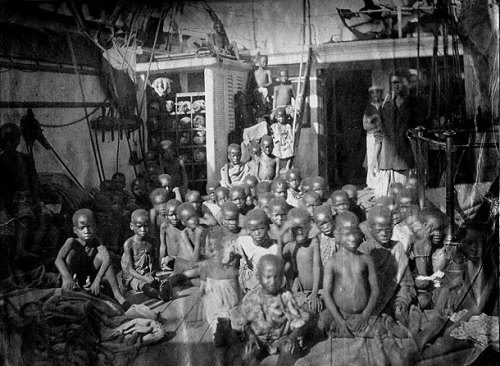
The UK Guardian, "Archaeologists find graves containing bodies of 5,000 slaves on remote island
Africans died in custody of Royal Navy in 1800s, after being seized from ships of slave traders, and were buried on St Helena," on 8 March 2012 -- British archaeologists have unearthed a slave burial ground containing an estimated 5,000 bodies on a remote South Atlantic island.
The corpses were found on tiny St Helena, 1,000 miles off the coast of south-west Africa. Those who died were slaves taken off the ships of slave traders by the Royal Navy in the 1800s, when Britain was supressing the slavery in the Caribbean. Many of the captives died after being kept on the slavers' ships in appalling conditions, and later in refugee camps when they reached the island.

According to Britain's National Archives, between 1808 and 1869 the Royal Navy seized more than 1,600 slave ships and freed about 150,000 Africans.
The dig, held in advance of the construction of a new airport on the island, revealed the horrors of the Atlantic slave trade.
The Middle Passage was the name of the route taken by ships transporting slaves from Africa to the new world.
It was the second leg of a triangular journey undertaken by European ships. The first leg would involve them taking manufactured goods to Africa, which they would trade for slaves.

After the Africans were delivered to the West Indies and Brazil (and, until the abolition slavery in 1809, the US), the ships would take raw materials back to Europe.
Experts from Bristol University led the dig. One of them, Prof Mark Horton, said: "Here we have the victims of the Middle Passage – one of the greatest crimes against humanity – not just as numbers, but as human beings.
"These remains are certainly some of the most moving that I have ever seen in my archaeological career."

St Helena was the landing place for many of the slaves taken off slaver ships captured by the navy during the suppression of the trade between 1840 – when the island became the base for the squadron leading the Royal Navy's offensive against the slavers – and 1872.
About 26,000 freed slaves were brought to the island, with most being landed at a depot in Rupert's Bay. Rupert's Valley – an arid, shadeless and always windy tract – was also poorly suited for use as a hospital and refugee camp for such large numbers.

Only five individuals were buried in coffins – one adolescent and four stillborn or newborn babies. The others had been put directly in shallow graves before being hastily covered. In some cases mothers were buried with their children. Dr Andrew Pearson of the university said 83% of the bodies were those of children, teenagers or young adults. Youngsters were often prime material for slave traders, who sought victims with long potential working lives. (source: Island Mix)
The university archaeologists have so far unearthed 325 bodies in individual, multiple and mass graves. They estimate the site contains a total of about 5,000 bodies, but these seem likely to be left where they lie. Horton noted that the archaeological excavations cover only the portion of the burial area that would have been disturbed by the new road were investigated.
Dr Andrew Pearson of the university said 83% of the bodies were those of children, teenagers or young adults.
Youngsters were often prime material for slave traders, who sought victims with long potential working lives.
Most causes of death could not be established on the bodies as the main killers – dehydration, dysentery and smallpox – leave no pathological trace.

But experts found scurvy was widespread on the skeletons and several showed indications of violence, including two older children who appeared to have been shot.
The team found evidence the victims were from a rich culture, with a strong sense of ethnic and personal identity.
A few had managed to retain items of jewelry such as beads and bracelets, despite the physical stripping process that would have taken place after their capture.

A number of metal tags were also found on the bodies that would have identified the slaves by name or number.
Pearson, the director of the project, said: "Studies of slavery usually deal with unimaginable numbers, work on an impersonal level and, in so doing, overlook the individual victims.
"In Rupert's Valley, however, the archaeology brings us quite literally face-to-face with the human consequences of the slave trade."
Excavated artefacts will be transferred to Liverpool for an exhibition at the International Slavery Museum in 2013. The human remains will be re-interred on St Helena.

• This article was corrected and clarified on 12 March 2012. The original referred to slaves "captured" by the Royal Navy, who then went on to die "after being kept on British ships in appalling conditions". What it meant was slaves from captured slaver ships, where conditions caused many to die at the time or in the ensuing days and weeks. The story also implied that the Bristol University archeologists might be intending to excavate the whole St Helena burial site with its estimated 5,000 bodies. This is not the case. (source: UK Guardian,)

No comments:
Post a Comment